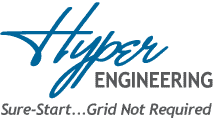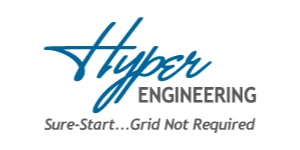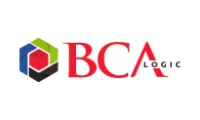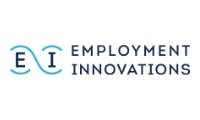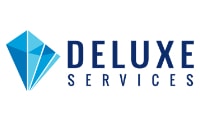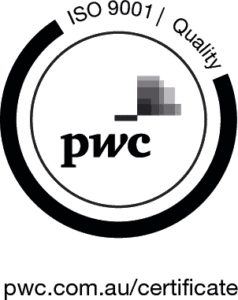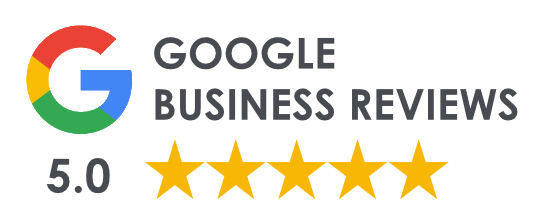ISO 9001:2015
Quality Management Systems
Need assistance with achieving and maintaining Certification to the ISO 9001:2015 Standard?
Book a FREE Strategy Session to discuss the best solution for your business, and how we can help you.
Does your business need to achieve or maintain Certification to the ISO 9001:2015 Standard in order to win your next big contract, while growing and improving your business?
Let our expert ISO Management System Consultants guide you with a tailored approach to meet your goals!
What is the ISO 9001:2015 Quality Management System Standard?
The ISO 9001:2015 Quality Management System Standard provides a framework for world-class business growth via a risk and opportunity based process approach to managing businesses. Globally recognised as the most popular management system standard, it enables businesses to achieve consistent performance and service, while meeting, and sometimes exceeding, customer expectations.
In simple terms, ISO 9001:2015 is a set of requirements that organisations can implement to ensure they provide high-quality products and services consistently. It involves establishing processes that ensure quality is maintained throughout the entire production or service delivery process, from start to finish. Organisations that are certified to ISO 9001:2015 can demonstrate to their customers that they are committed to delivering quality products and services.
The standard’s requirements are developed to fit organisations of all types, sizes and industries, so no matter what business you operate, you will undoubtedly notice the many measurable benefits.

ISO Standard Documents
The ISO 9001:2015 Standard is an actual document developed by the International Organisation for Standardisation (ISO) detailing the standard’s clauses and requirements. We highly recommend that you purchase the ISO 9001:2015 Standard document, to fully understand the requirements for successful implementation. Visit Standards Australia to purchase a copy.
Why ISO 9001?
Achieving ISO 9001:2015 Certification is an essential step for any size organisation seeking to establish an internationally recognised Quality Management System (QMS), and harness the benefits of a powerful business improvement tool. ISO 9001 sets a globally acknowledged standard for ensuring consistent product or service quality, customer satisfaction, and continual operational improvement and efficiency.
By achieving this Certification, organisations demonstrate to their stakeholders their commitment to adhering to best practices, therefore boosting credibility in the market. As put by our clients, the Certification demonstrates that they are serious about their business, achieving consistency across the organisation with a robust and well established business structure.
In fact, achieving Certification to ISO 9001 can be a critical competitive advantage while also expanding your market potential by qualifying your business for bigger and better projects, such as government tenders and grants. It can also help organisations meet other contract or product requirements, as well as be used to help lower insurance premiums.
Achieving Certification to ISO 9001 serves as a strategic advantage, instilling confidence in both internal and external relationships, positioning the organisation for sustainable growth and success in today’s competitive business landscape.
Who needs ISO 9001 Certification?
ISO 9001:2015 Certification is relevant and beneficial for organisations of all sizes and industries. Any business can achieve Certification to ISO 9001 to demonstrate its commitment to meeting customer requirements and ensuring continual improvement.
From manufacturing and construction firms to healthcare providers, tech businesses, and service-oriented businesses, ISO 9001 can benefit any organisation seeking to improve efficiency, streamline processes, and maintain a strong commitment to meeting customer needs and regulatory requirements. The standard is designed to be generic and flexible, meaning that the requirements can be adapted to any industry, regardless of size.
The process of implementing the requirements of ISO 9001 is similar regardless of the size of your business; it will be adapted to the scale and needs of each organisation. ISO 9001 is a solid first standard that many businesses opt for, as it’s designed to support your business in delivering a quality service and satisfying your customers. An obvious target for any sized organisation.
We’ve helped over 200 client organisations achieve Certification across 15 different industries and many different sized enterprises. Want to check if ISO 9001 is the right fit for your business? Book a FREE Strategy Session to discuss your needs.
Benefits of ISO 9001:2015 Quality Management Systems

Enhance customer satisfaction via consistent quality with fewer errors

Facilitate business growth via continual improvement

Improve traceability and accountability

Benefit from evidence-based decision making

Greater control and management of quality risks
General Benefits of ISO Management System Standards

Qualify for more tenders, contracts and international trade

Increase and improve brand reputation to boost stakeholder confidence

Improve business planning and align with organisational strategy

Higher profit margins and reduced costs through improved efficiencies

Improve business structure and standardise systems for sustainable growth
Steps of ISO 9001 Certification Process
01
Planning
Understanding the requirements of the ISO 9001 standard is crucial. Planning may also involve conducting a Gap Analysis to understand the organisation’s current status against the ISO 9001 requirements, if not starting from scratch. A plan is developed to address these gaps and establish a roadmap for the Certification Process.
02
Documentation Development
During this stage, a Quality Management System (QMS) must be developed by creating the necessary documentation, including quality policies, procedures, and work instructions, and business planning documentation. This is where the expertise in understanding and applying the Standard requirements comes into play, and expert consultants help you save money and time by tackling this strategically.
03
Implementation
The QMS is put into practice across the organisation, and employees should be guided to understand the documentation, as well as their roles and responsibilities. Conducting an Internal Audit and a Management Review are also requirements, to ensure that processes are implemented, followed, and executed accordingly, and the ISO 9001 requirements have been met in preparation for the external audits.
04
External Audits
At this step, you need to engage a Certification Body (aka Conformity Assessment Bodies). They are the accredited organisations that will conduct the Certification (External) Audits to assess your organisation’s QMS against the ISO 9001 requirements. Auditors will evaluate the management system’s effectiveness, its alignment with the ISO 9001 standard, and its ability to deliver consistent results. Upon successful completion of the External Audit, your organisation will receive your ISO 9001 Certification. Find out how to select the right Certification Body for your business here.
05
Continual Improvement
Once Certification is achieved, it’s valid for 3 years, and your Certification Body will return to conduct annual surveillance audits to ensure your business maintains its commitment to quality management. Ongoing activities are required by your organisation to be regularly conducted ensuring your QMS still meets the requirements of the ISO 9001 standard, and evidence of these will be checked by your Certification Body auditor. Find out more here.
The Certification Readiness journey for ISO 9001
The Certification Readiness Process is broken down into 3 Phases. We can tailor our service for you depending on your needs. The infographic shows the steps of the entire process.
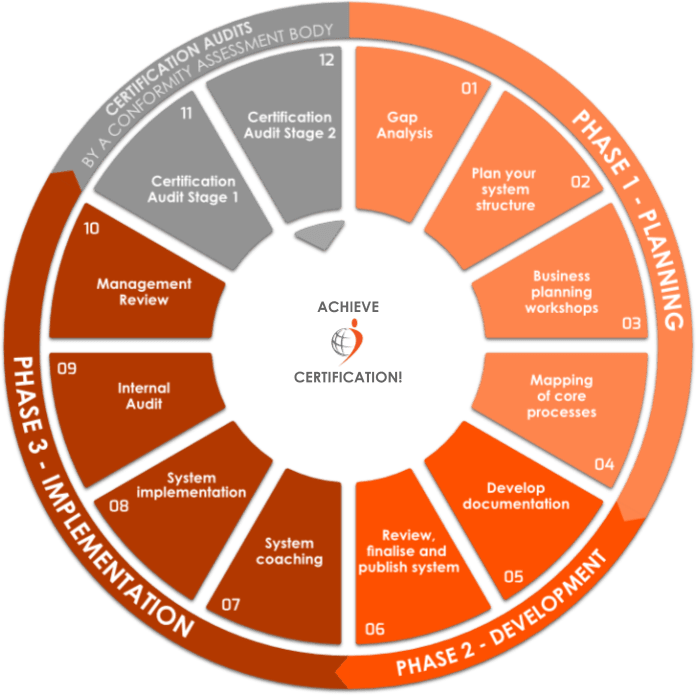
Get your FREE Certification Readiness Process Diagram today!
How we can assist you
Our services are customisable for each business, depending on your specific needs.
Certification Readiness
Consulting Services to help your business get ready for Certification, including provision of a bespoke management system to suit each individual business, and meet the ISO 9001:2015 Standard requirements, ensuring you get Certified the first time.
Certification Ongoing Support
Support and guidance with meeting the ongoing requirements of your Quality Management System. We manage your Internal Audit program and other activities required annually to ensure continued conformance with the ISO 9001:2015 Standard.
Auditing
Our Internal Audit services offer a systematic and independent assessment of your Quality Management System to determine its effectiveness and facilitate continual improvement, ensuring the ISO 9001:2015 requirements are met. We also provide Second Party Audit services.
Training
Internationally Recognised eLearning training for supporting you with your Management System needs. Practical, self-study, and engaging online courses suitable to individuals or organisations of all sizes and industries.
Ready to get started?
Book a FREE Strategy Session with us to discuss the best approach for your business, understand the benefits for your organisation, and find out how we can best help you achieve your goals!
What our clients have to say
History of ISO 9001
The ISO technical committees conduct reviews of all ISO Standards approximately every five years. In the event that a standard is revised and updated as a result of such a review, a new version of the standard will be published by the International Organization for Standardization (ISO), with the new title including the year in which the revision was made.
The ISO 9001 Standard was first published in 1987, and has since undergone several revisions to better meet the changing needs of organisations and stakeholders. Here is a brief history of the development and published versions of ISO 9001:
ISO 9001:1987
Withdrawn
ISO 9001 was first published by ISO in 1987. It was originally based on the British Standard BS 5750, which was developed in the 1970s.
ISO 9001:1994
Withdrawn
The standard was revised and updated and published alongside other related quality standards: ISO 9002:1994 and ISO 9003:1994.
ISO 9001:2000
Withdrawn
A major revision of the standard was undertaken to make it generic and applicable to all organisations, regardless of type, size and products provided. This revision resulted in ISO 9002 and ISO 9003 being withdrawn.
ISO 9001:2008
Withdrawn
After another revision, this version emphasised the importance of continual improvement and customer satisfaction.
ISO 9001:2015
Current Version
This is the current version and is focused more on risk-based thinking, context of the organisation, leadership and taking a process approach to the management system.

